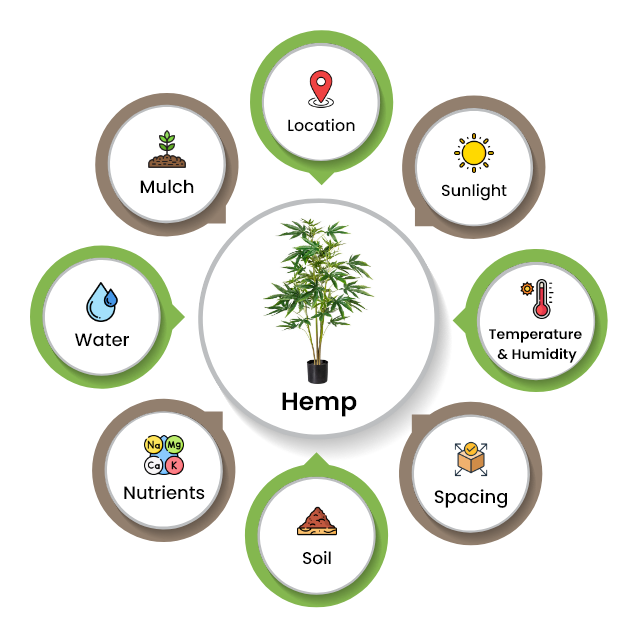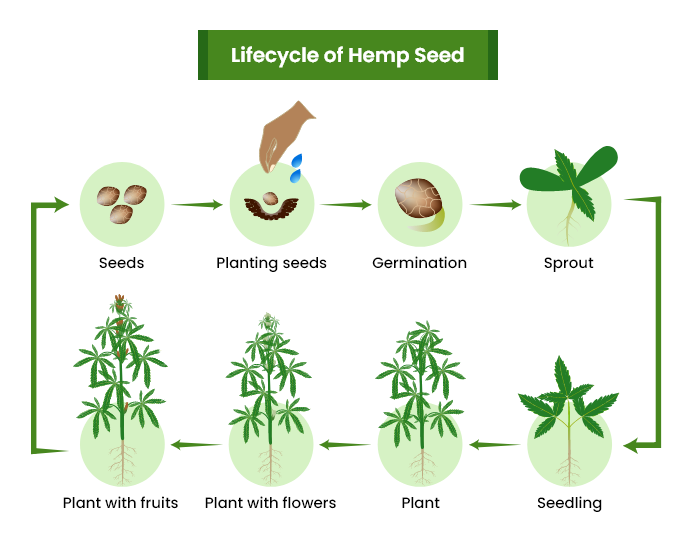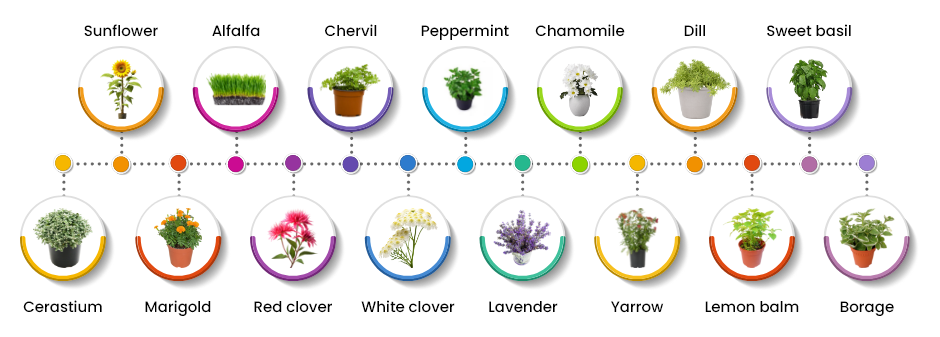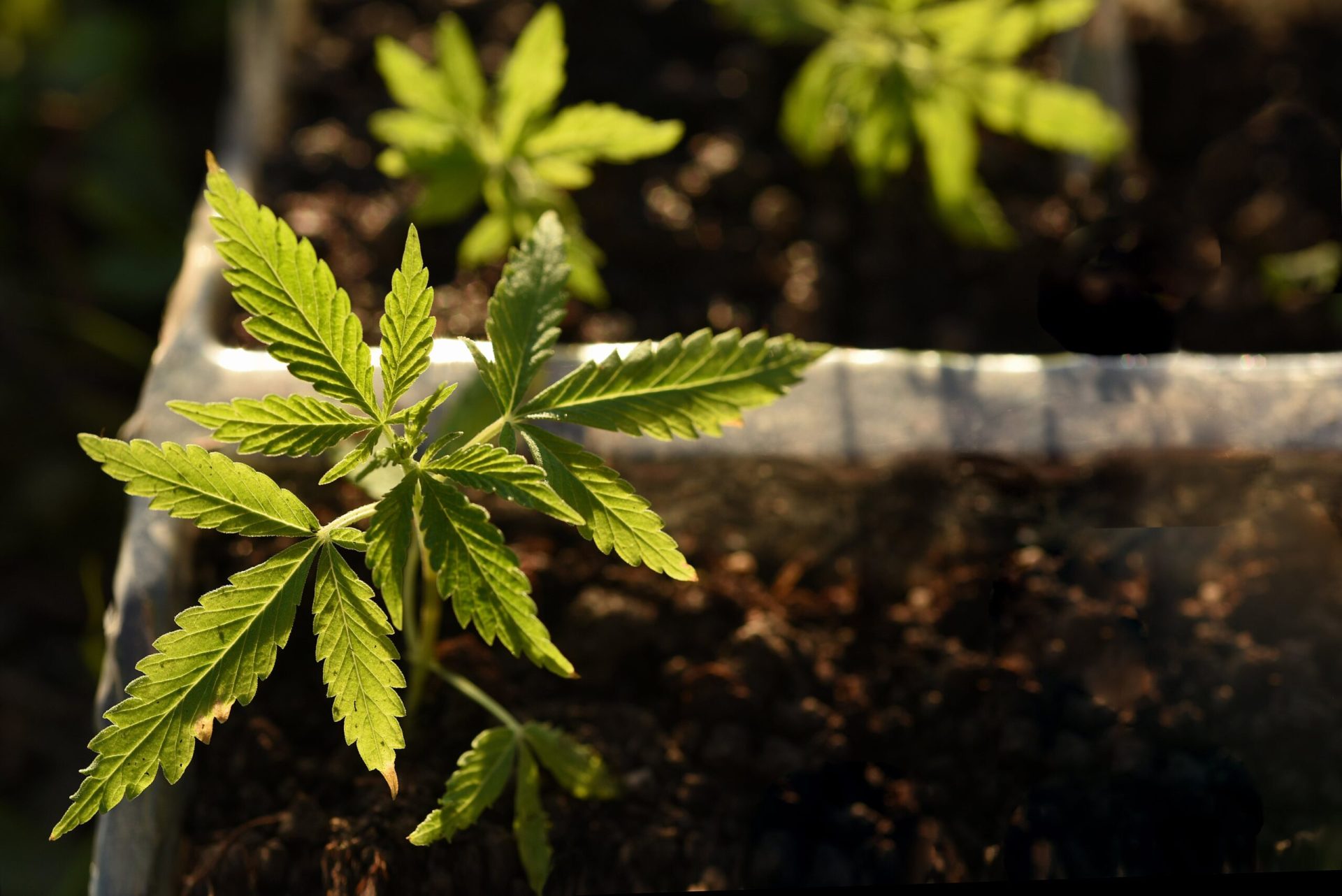Growing hemp is a huge undertaking, and its growing process is more complex than many other crops. Therefore, knowing where to start and implementing the proper steps can make a big difference. Beyond its association with CBD, hemp is a resilient and sustainable crop with a myriad of uses.
Wondering how to grow hemp? This hemp growing guide is your go-to resource. It covers everything you need to know about growing this incredible plant.
From seed to harvest, let’s explore how to cultivate hemp successfully. We’ll cover its essential growing needs, hemp growing stages, harvesting tips, and more.
Growing Hemp 101: Step-by-Step Guide

1. Location
Hemp likes a warm, humid environment to thrive. In colder climates, indoor growing may be best.
2. Light
Choose a location that receives full sun (at least 6-8 hours of direct sunlight per day).
3. Temperature and Humidity
Hemp prefers a warm growing season and thrives in temperatures between 60 and 80°F.
4. Spacing
For CBD flower production, hemp plants should be spaced about 4 to 6 feet apart with 5 to 8 feet between rows.
5. Soil
Hemp plants prefer well-draining, loamy, and fertile soil enriched with organic matter. The soil should have a pH level of 6-7.5.
6. Nutrients
Provide your hemp plants with fertilizer that has an NPK ratio of 2:1:2.
7. Water
Hemp plants require at least 20 to 30 inches of water during their growth cycle.
8. Mulch
Use organic mulch like straw or wood chips for hemp cultivation.
When and How to Plant Hemp Seeds?
Sow your hemp seeds after the last frost date has passed. Plant the seeds by spacing 3 to 6 feet apart if space allows. This provides enough space for your plants to grow and reach full maturity.
Once your seeds are in the ground, water them deeply once a week, early in the morning or at dusk, to prevent evaporation. Seeds will sprout in 5-10 days, although some might take up to 2 weeks.
How do you grow hemp from seed?
- Select seeds based on your desired product crop (fiber, grain, or CBD flower).
- Select a germination method either directly in the field or indoor germination.
- When starting indoors, use seedling trays with a high-quality seed-starting mix.
- Plant seeds at the recommended depth of around ½ to 1 inch deep.
- Keep soil consistently moist during the germination period, which is 5 to 10 days.
- Maintain a consistent soil temperature between 65°F to 70°F for optimal germination.
- Once seedlings emerge, provide sufficient light. Use grow lights or place seedlings in a sunny location.
- Transplant seedlings to large containers or directly into the ground when they develop a proper set of leaves.
Growing Hemp in Containers
Growing hemp plants in pots or containers is the best option for those with limited space or those who prefer the flexibility of container gardening. Here are some tips:
- Choose a hemp variety suitable for container gardening and well-suited to the available space and climate.
- Select a properly sized container with ample drainage.
- Start the growing process by germinating hemp seeds.
- Use seed trays or start the germination in small pots using seedling mix.
- Fill containers with a well-draining potting mix. The soil should be slightly acidic to neutral. It should have a pH between 6-7.5.
- Once the seedlings develop a few sets of true leaves, transplant them into larger containers.
- Keep proper spacing between plants.
- Hemp plants require full sunlight for optimal growth.
- Place the container in a location that receives at least 6-8 hours of sunlight per day.
- Water your hemp plants consistently by keeping the soil moist, but don’t overwater.
- Use a balanced fertilizer or a fertilizer formulated specially for hemp.
- Consider pruning and training the hemp plants if they grow tall quickly.
- Inspect plants for pests and diseases at regular intervals.
- Harvest your hemp crop when the plant reaches the desired maturity level.
How to Transplant Hemp Seedlings
Changing the pot quickly and cleanly is essential so the plant doesn’t suffer stress.
- Before transplanting the seedlings – water them 1-2 days beforehand. The soil should be moist and compact but not soaked.
- Choose a quality substrate to fill the plant’s new container. Refrain from filling it to the top; the soil should be sufficiently compacted. Ensure the substrate is free of pathogens and provides the roots with the necessary nutrients for the crop.
- Place your hand on the soil and turn the pot upside down. Carefully slide the root ball out of the top.
- Once you extract it, place your hand under the root ball and transfer it to the new container with a hole at the bottom. Cover the hole with soil.
- Water slightly as it helps plants to get used to their new home.
Hemp Growing Stages

The growing stages of the hemp plant can be classified into 4 stages, from germination to harvesting the flower:
1. Germination
During the germination stage, the seeds develop a taproot to establish themselves in the growing medium. Once the plant stabilizes itself, it pushes its main stem above the ground and exposes its first leaves.
2. Seedling
In this stage, the plant establishes its root structure to prepare for water and nutrient intake. The root structure establishment takes about 1-2 weeks which is vital to the plant’s vegetative growth. The plant enters the vegetative stage after the root structure has fully developed.
3. Vegetative
The vegetative stage encourages leaf and stem growth above the ground. In this stage, you can use a nitrogen-rich fertilizer to provide nutrients for new stem and leaf development. Once the plant reaches its desired size, reduce light exposure to 12 hours per day or less.
4. Flowering
The flowering stage is split into two sub-phases. The first one is the pre-flowering phase – the plant experiences a growth spurt and grows to an increased height of 50-100%. In the second sub-phase, white pistils appear on its nodes and stems, if the plant is female. If the plant is male, pollen sacs appear on its nodes and at the end of its stems instead.
How to Harvest Hemp Seeds
Harvesting hemp seeds from the plant wait until the seeds have fully matured. This is important for optimal grain or oil production.
To harvest hemp seeds, follow these steps:
- Seeds should be fully mature. The flowering stage indicates seed development.
- Seeds are typically ready for harvest when they turn brown, and the seed heads begin to droop.
- Inspect the seed heads to ensure that a significant portion have matured.
- Use harvesting tools like shears to cut the hemp plant at the base.
- Hang the harvested plants upside down to allow for air circulation and drying.
- When the plants are dried, remove the seeds and any remaining material.
- After seed removal, the winnowing process separates seeds from the plant.
- Clean the harvested seeds by removing any chaff or debris.
- Store the clean and sorted seeds in airtight containers or glass jars to preserve their freshness and protect them from moisture.
How Do You Store Hemp Seeds?
To store hemp seeds, follow these steps to maintain their freshness and quality for a long time:
- Store hemp seeds in a cool and dry environment.
- Store hemp seeds at 40° to 50°F for optimal freshness.
- Humidity levels should be kept low.
- Ensure that the storage area is dry and free from any moisture.
- Use airtight containers or packaging to reduce air exposure and preserve the seeds’ freshness.
- Avoid storing hemp seeds near strong-smelling substances as they absorb odors quickly.
- Store them away from direct sunlight or other light sources, which can decrease their quality.
Best Hemp Varieties
The hemp seed variety is selected based on its intended use (CBD flower, seeds, or fiber), local regulations, and climate. Some of the best hemp varieties for CBD production include Futura 75, Cherry Wine, and Suver Hazer.
1. Futura 75
This hemp variety is renowned for its high CBD and low THC levels. This makes it compliant with legal regulations. It is cultivated mainly for its CBD extraction. Several hemp farmers favor it for its high fiber yields. As it has a high fiber content, it can produce high fiber yields of excellent quality.
It can adjust to different climates and soil types, which makes it suitable for cultivation in diverse regions. It produces robust plants with dense foliage, displaying the resilience and stability that hemp enthusiasts seek.
2. Cherry Wine
This hemp seed variety is appreciated for its incredible CBD and minuscule THC levels. Its sweet, cherry flavor, and fruity aroma, makes it an attractive choice for CBD extraction and smokable flower markets. It has aromatic and flavorful buds and focuses on terpene-rich profiles.
It is often preferred due to its potential therapeutic effects and ability to succeed in different environments. This makes it a versatile and highly preferred option for hemp cultivation.
3. Suver Haze
This hemp variety is known for its high CBD content and distinctive terpene profile. It has a pungent and earthy aroma. It is known for its vibrant green buds and energetic growth. It is popular among farmers and consumers.
It has potential calming effects, which makes it a preferred choice for those seeking a hemp strain with potential wellness benefits. Its robust and vigorous nature makes it suitable for outdoor and indoor cultivation.
Common Pests and Problems with Hemp Seeds
Like any crop, hemp is susceptible to various pests and problems. Some common pests and problems that might affect the growth of hemp seeds are:
- Aphids
- Spider mites
- Beetles
- Caterpillars
- Powdery mildew
- Botrytis
- Root rot
- Bacterial blight.
It is essential to regularly monitor hemp plants for early detection and adopt proactive management practices. This is crucial for reducing the impact of pests and problems on your hemp seed production.
Companion Plants for Hemp

Some companion plants to try with hemp include:
- Chamomile
- Sweet basil or lemon balm
- Sunflowers
- Beans
- Chrysanthemum,
- Garlic
- Coriander
- Lavender
- Peppermint



